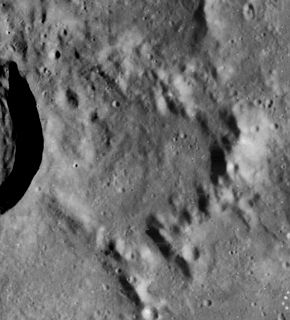Tempel (crater)
 Mosaic of Lunar Orbiter 4 images | |
| Coordinates | 3°54′N 11°54′E / 3.9°N 11.9°E |
|---|---|
| Diameter | 45 km |
| Depth | 1.3 km |
| Colongitude | 348° at sunrise |
| Eponym | Ernest W. L. Tempel |
Tempel is the remnant of a lunar impact crater whose outer rim has been eroded, indented, and reshaped by subsequent impacts and lava flows. It is attached to the eastern rim of the crater Agrippa, in an area that has been resurfaced by old lava flows. More than 40 km southwest is Godin, and 25 km to the east lies the small, bowl-shaped Whewell.
The crater is named after an astronomer Ernest W. Leberecht Tempel who discovered 9P/Tempel (Tempel 1), 10P/Tempel (Tempel 2) and two other comets.
Its diameter is 45 km long and is 1,300 meters deep. Also, the area is more than 600 km² and the perimeter is around 100 km.
There is a gap in the northwestern rim of Tempel that forms a protrusion that follows the rim of Agrippa. Smaller gaps exist in the southern rim, and the relatively flat interior surface of the crater is joined by these valley clefts to the lava-covered exterior. From here the flow can be followed eastwards until it joins the Mare Tranquillitatis. Little of the original rim remains intact, and the formation is now a somewhat circular range of rounded, irregular ridges.
References
- Andersson, L. E.; Whitaker, E. A. (1982). NASA Catalogue of Lunar Nomenclature. NASA RP-1097.
{{cite book}}: Invalid|ref=harv(help) - Blue, Jennifer (July 25, 2007). "Gazetteer of Planetary Nomenclature". USGS. Retrieved 2007-08-05.
{{cite web}}: Invalid|ref=harv(help) - Bussey, B.; Spudis, P. (2004). The Clementine Atlas of the Moon. New York: Cambridge University Press. ISBN 978-0-521-81528-4.
{{cite book}}: Invalid|ref=harv(help) - Cocks, Elijah E.; Cocks, Josiah C. (1995). Who's Who on the Moon: A Biographical Dictionary of Lunar Nomenclature. Tudor Publishers. ISBN 978-0-936389-27-1.
{{cite book}}: Invalid|ref=harv(help) - McDowell, Jonathan (July 15, 2007). "Lunar Nomenclature". Jonathan's Space Report. Retrieved 2007-10-24.
{{cite web}}: Invalid|ref=harv(help) - Menzel, D. H.; Minnaert, M.; Levin, B.; Dollfus, A.; Bell, B. (1971). "Report on Lunar Nomenclature by the Working Group of Commission 17 of the IAU". Space Science Reviews. 12 (2): 136–186. Bibcode:1971SSRv...12..136M. doi:10.1007/BF00171763.
{{cite journal}}: Invalid|ref=harv(help) - Moore, Patrick (2001). On the Moon. Sterling Publishing Co. ISBN 978-0-304-35469-6.
{{cite book}}: Invalid|ref=harv(help) - Price, Fred W. (1988). The Moon Observer's Handbook. Cambridge University Press. ISBN 978-0-521-33500-3.
{{cite book}}: Invalid|ref=harv(help) - Rükl, Antonín (1990). Atlas of the Moon. Kalmbach Books. ISBN 978-0-913135-17-4.
{{cite book}}: Invalid|ref=harv(help) - Webb, Rev. T. W. (1962). Celestial Objects for Common Telescopes (6th revised ed.). Dover. ISBN 978-0-486-20917-3.
{{cite book}}: Invalid|ref=harv(help) - Whitaker, Ewen A. (1999). Mapping and Naming the Moon. Cambridge University Press. ISBN 978-0-521-62248-6.
{{cite book}}: Invalid|ref=harv(help) - Wlasuk, Peter T. (2000). Observing the Moon. Springer. ISBN 978-1-85233-193-1.
{{cite book}}: Invalid|ref=harv(help)
External links
Other articles
- Wood, Chuck (December 12, 2006). "How Deep is That Hole". Lunar Photo of the Day. Archived from the original on August 3, 2017.
{{cite web}}:|archive-date=/|archive-url=timestamp mismatch; June 14, 2011 suggested (help); Unknown parameter|deadurl=ignored (|url-status=suggested) (help)
